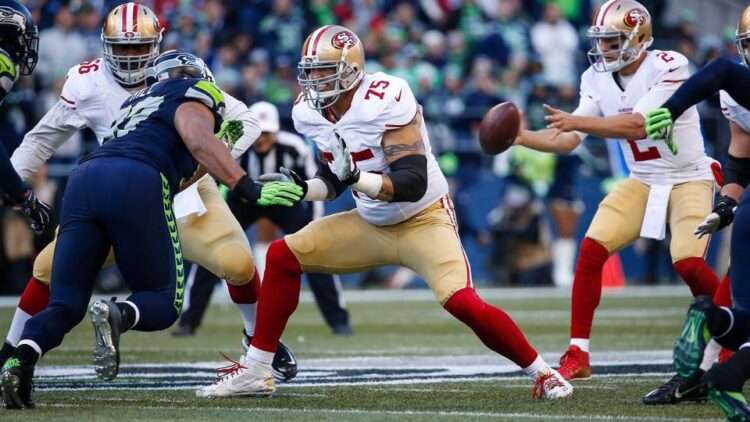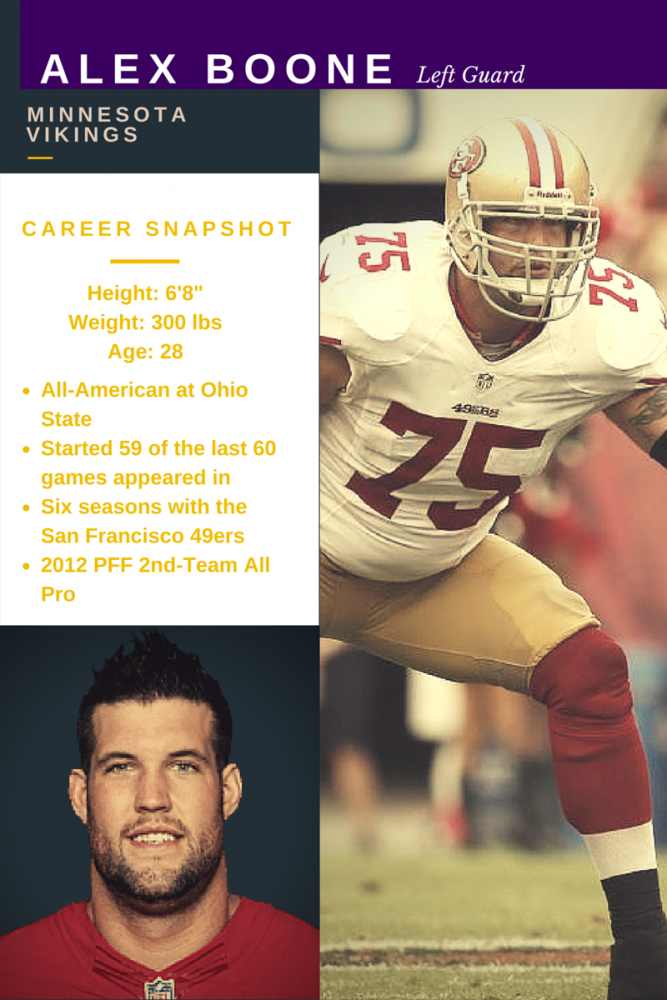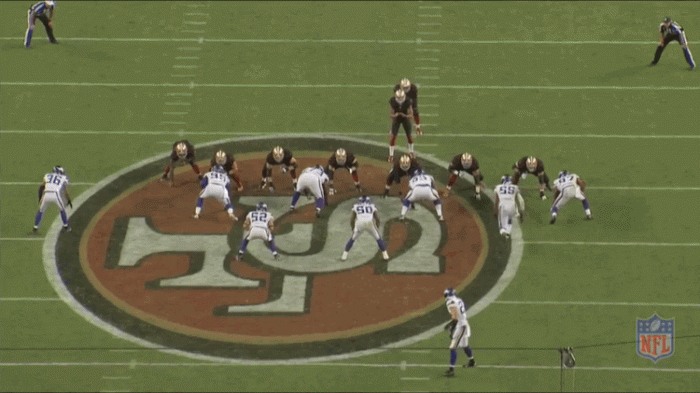Welcome Aboard: Vikings G Alex Boone

Alex Boone is a throwback offensive lineman. He’ll head-butt his quarterback without a helmet. He’ll threaten to punch a certain Green Bay Packers linebacker in the mouth. But most of all, he’ll bring that in-your-face attitude to the field, where he’s earned a reputation as one of the most physical guards in the NFL.
It’s part of the reason Mike Zimmer wanted Boone — who signed a four-year, $26.8 million contract this offseason — in a Minnesota Vikings uniform next year. “One of the things was his toughness, the physicality,” he said, per Chris Tomasson. ”I like his demeanor and I’m hoping it’s something that rubs off on the rest of our offensive line.”
But more than an attitude, what does Boone add to the unit, and how can he translate his game to improve what was one of Minnesota’s weakest links in 2015? It starts by looking at Boone’s film from last season, his final year with the San Francisco 49ers. A career right guard, he made the full-time transition to the opposite side and started 13 games at the position, finishing the season with a 65.0 overall grade from Pro Football Focus (PFF).
Though he finished with a 44.9 run blocking grade, Boone excelled in pass protection, earning a 82.1 grade for his work over 13 games. According to PFF, he allowed just three sacks and 17 total pressures all of last year — music to Teddy Bridgewater’s ears.

Image designed by Austin Belisle
Learn more about Boone’s journey through the NFL
A six-year veteran, Boone’s experiences go deeper than playing left guard. At Ohio State, he made 22 of his 35 starts at left tackle, and between 2012 and 2013, started 32 games for the 49ers at right guard. It wasn’t until 2015 that he made the transition to left side, and did so with an open mind.”Footwork’s a little diferent, handwork is a little different, but at the end of the day it’s come along real well,” he said, per ESPN.
Geep Chryst, the offensive coordinator at the time, believed moving Boone to left guard gave the unit as a whole flexibility, as Boone could play one of three positions — right guard, left guard, or left tackle. He’ll begin his career as a Viking at left guard, but Boone comes to Minnesota facing a similar situation.
Rick Spielman used the free agency period to create competition at all five spots of the line, from Boone at left guard to Andre Smith at right tackle or right guard. While Boone won’t face any challengers come training camp, three of the four other positions may see turnover. Having a surefire starter in Boone next to left tackle Matt Kalil allows Tony Sparano and the coaching staff to focus their efforts on addressing the uncertain status of the starters on the right side of the line.
Road Grader
Boone wanted to punch Clay Matthews in the face last year, but his desire for aggression goes much further back. In 2013, he spoke to the 49ers media team and opined for an old-school, hard-nosed brand of football.
[quote_center]”I feel like offensive lines in this league have gotten away from what they used to be. You watch the old tape of guys like Jonathan Ogden, Tony Boselli and those guys – they were nasty guys. They would hit you in the mouth and they didn’t care.”[/quote_center]
That mentality shows up on the field, especially in the running game. Boone may have scored poorly (according to PFF) in such situations last season, but he’s been an above-average run blocker for the majority of his career. Aside from his colossal size, he knows how to move within the trenches, angling his body and timing his blocks to gain leverage on defenders.
This is especially true when working through double teams and moving to the second level of the defense. He’s strong enough to chip down lineman and has the quick feet to transition from a double team to a block in space. It’s difficult, especially for smaller linebackers, cornerbacks, and safeties, to take on a block from a guard in a tackle’s body; and that’s exactly what Boone is.
In the examples above, watch Boone’s hand placement and leg drive when blocking down, especially against the Vikings and Linval Joseph in Week 1. He opens his hips at the snap of the ball and fires to his right, cutting off Joseph before the nose tackle can penetrate into the backfield. His head, in front of Joseph’s chest, is exactly where it needs to be, and he continues to drive his legs on contact. As for his hands, they’re locked into Joesph’s chest, and his elbows are tucked in, allowing for a more explosive punch when the two meet.
When moving to the second level, it’s Boone’s hands and arms that make him so dangerous. Yes, he’s strong and can easily shed down linemen, but when he engages linebackers, it’s almost always an unfair fight. He locks his hands into the chests of oncoming defenders, and his reach alone creates enough distance to render the linebacker or safety helpless.
These plays, where Boone is double-teaming and releasing almost immediately, resemble many of the same plays the Vikings ran with Adrian Peterson last season. On the right side of the line, Mike Harris and T.J. Clemmings often double-teamed at the point of attack, allowing Peterson to pick and choose which holes he’d rush through. Double teams became a staple of the offense, and mixed with tight end-heavy sets, morphed the scheme into a run-first attack that allowed Peterson to win his third-career rushing title.
Savvy and Speedy

With Adrian Peterson in the backfield, the Vikings like to pull offensive linemen and run power/counter concepts. Here, Boone releases from the play-side guard position, lead-blocking for the running back down the field. Expect to see Boone doing similar things for Peterson next year, much as Mike Harris did in 2015.
Boone’s size allows him to win in the trenches, and it’s that same size that makes his ability in space so surprising. When asked to pull, Boone fires out quickly, maintaining adequate distance — 3-4 yards ahead — between himself and the running back. The example above, another embarrassment for the Vikings, shows off Boone’s understanding of body position, blocking angles, and most importantly, his movement in space.
The other examples above present a new wrinkle of Boone’s game, a wrinkle that’s difficult to define. Much like he understands his own body positioning and the blocking angles in space, he appears to have a firm grasp on the movements of defensive lineman. He’s a savvy lineman, but more than that, Boone has the ability to translate a defensive lineman’s positive momentum into a negative result for the defense. It’s a trick that requires years of practice, and one that can easily backfire with poor hand placement or timing.
In the plays above, he positions himself and times his blocks perfectly, allowing defenders to rush upfield, only to negate their momentum and completely take them out of the play. Such blocks require a running back (like Adrian Peterson) with advanced vision and the ability to identify non-threats in the backfield. Boone, as the signal-caller for the offensive line in San Francisco last year, understood his responsibilities long before the snap. He put himself in situations to make extremely difficult blocks and did so, often times with ease.
All Aboard!
Boone is a powerful, deceptively quick, and versatile offensive lineman. Not only can he play multiple positions along the offensive line, but he can thrive in a number of different schemes. The film above represents a small sample of his work with the 49ers, which includes examples of man-blocking, power/counter designs, and double-teams on down defensive linemen.
While Boone’s had his fair share of injuries and personal problems, he appears to be over the hump and committed to playing some of his best football for the Vikings. If he can translate some of the positive traits outlined above to the field next season, Minnesota will no doubt be better along the offensive line in 2016.

You must be logged in to post a comment.